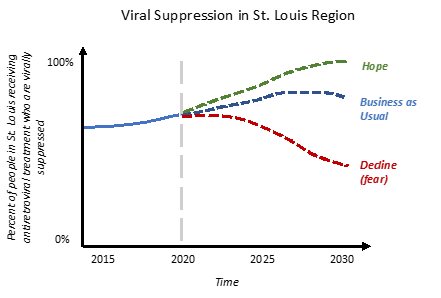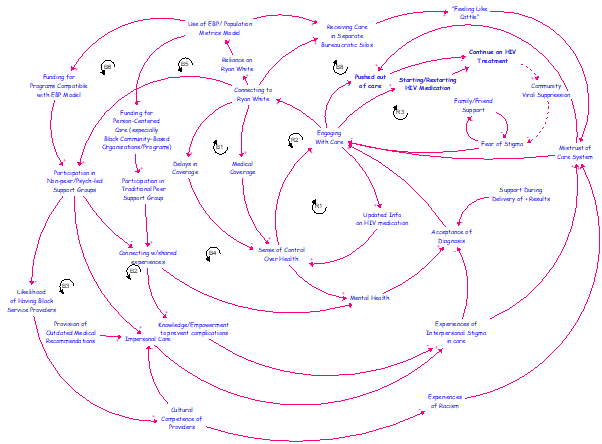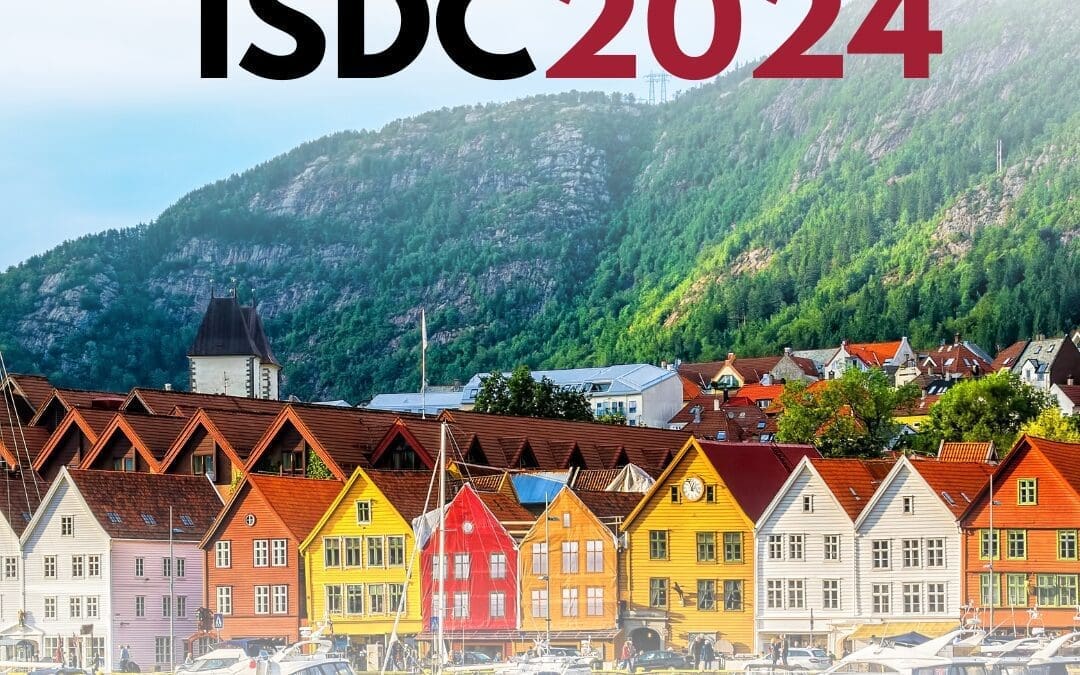Fast-Track Cities Uses System Dynamics to Enhance HIV Care
EXECUTIVE Summary
-
Low levels of viral suppression at 69% for people with HIV make it hard to believe the 95% target level will be achieved by 2030 in St. Louis, USA.
-
As a solution, Fast-Track Cities-STL opted to use group model building means to 1) gain understanding of the fragmented service landscape and 2) to empower the community to address causes of health inequality.
-
The causal loop diagram revealed the importance of community-building for care engagement and created the foundation to build capacity by generating interest and commitment among participants. It also shed light on policies’ unintended consequences leading to service fragmentation and the need for rapid start programs to consider holistic social support for sustained care.
#Fast-Track Cities #HIV #Health #USA
The Problem
Levels of viral suppression at 69% for people living with HIV in St. Louis are far below the targeted goal of 95% required to end the HIV Epidemic in the City of St. Louis, U.S., by 2030.
To increase viral suppression, Fast-Track Cities- St. Louis created a subcommittee dedicated to expand access to rapid initiation of antiretroviral (ART) medication (also called Rapid Start) and to utilize a collaborative governance model to engage in consensus-oriented change. This initiative organized a series of group model building sessions, bringing together diverse stakeholders: those living with HIV, patient advocates, healthcare professionals, researchers, and policymakers. The objective of these sessions was threefold:
1. To identify structural barriers affecting the adoption and accessibility of Rapid Start services in St. Louis.
2. To comprehend the varying perceptions and mental models of providers and clients concerning HIV diagnosis and treatment.
3. To guide a standardized approach for implementing Rapid Start ART across different service providers.
Figure 1 – Behavior-over-time graph displaying the percentage of virally suppressed people receiving ART medication in the St. Louis region according to different outcome perceptions.

The Solution
The landscape of Rapid Start in St. Louis remains intricate. Despite three major healthcare providers rolling out rapid start programs, the data and insights from these initiatives have remained compartmentalized. Recognising this challenge, Fast-Track Cities-STL was compelled by the group model building approach as it offered an opportunity to map both the service provision landscape as well as important factors impacting quality HIV service while building capacity among communities. Fast-Track Cities-STL finds it incredibly important to utilize empowerment approaches to build a more agile, responsive public health HIV response.
Hence, the aim of Fast-Track Cities-STL was to use participatory group model building not only as means to uncover a greater understanding about the system of access to rapid start ART in the St. Louis region, but also to lay the groundwork for a grassroots community led collaborative in HIV care that aims at addressing the root causes of health inequities and outcomes. Fast-track Cities-STL anticipated that an interactive approach like group model building could help generate interest and community commitment in working on the solutions.
The resulting model combined insights from participatory GMB sessions involving those living with HIV in St. Louis, healthcare providers, and advocacy groups. The Causal Loop Diagram (CLD) crafted from this process comprised three reinforcing loops and eight feedback loops. Factors like mistrust, personal agency over health, peer support, and access to pivotal services emerged as the most influential determinants in the model’s behavior.
Figure 2 – The resulting CLD based on the GBM sessions.

Three fundamental feedback loops are highlighted. The “Problem of Delays” is a reinforcing loop where waiting for healthcare coverage causes individuals to lose their sense of control over their health. This diminished sense of control subsequently leads to decreased engagement within care spaces. Essentially, the longer the wait, the less control individuals feel, leading to even lesser engagement in care, creating a reinforcing cycle.
In the “Mistrust” balancing loop, experiences of racism and interpersonal stigma within the care system amplify mistrust. This heightened mistrust deters individuals from engaging with care, particularly in “non-peer-led groups.” As a result, they face a reduced risk of encountering cultural incompetency from providers. This loop underscores a critical insight: individuals who face racism and interpersonal stigma in care settings are more likely to disengage due to these negative experiences, balancing out their exposure to potential further harm.
The “Operation in Silos” balancing loop highlights how navigating care within bureaucratic silos makes individuals feel dehumanized, akin to “feeling like cattle.” This sentiment fosters greater mistrust, leading to decreased engagement in care. The more compartmentalized the care, the more individuals feel like mere numbers, leading to a balancing effect where they trust and engage less with the system.
Outcomes
The tangible outcome of the project was the CLD that participants developed and validated during the participatory group model building sessions. Key insights from the model revealed the importance of community-building opportunities for engagement in care, especially in the uptake of Rapid Start ART. The model also shed light on how some well-intentioned policies inadvertently led to service fragmentation and undermined the autonomy and peer support vital for those living with HIV. Furthermore, the model highlighted that the factors influencing the initiation of medication were intrinsically linked to the continuity of care. In essence, the model underscored the need for rapid start programs to holistically consider the social scaffolding essential for individuals to initiate and sustain care.
As aimed by the project, the Group Model Building approach also provided means to build capacity among communities disproportionately impacted by HIV and leverage their insights for system change. On the one hand, the insights offered by the model pointed out the importance of building community to generate engagement in care—including the uptake of Rapid Start ART. On the other hand, the project stimulated interest among participants and recruited them to continue their engagement with the organization; several individuals expressed a commitment to continue working on the project beyond the exercise.
Regrettably, a major setback led to a leadership vacuum, halting the initiative. Nonetheless, a participating organization has taken the baton, advancing the rapid initiation of ART services.
Do you want to know more?
Connect with Megan Keenan
OTHER SUCCESSFUL APPLICATIONS
System Dynamics Helps Evaluate Anticipatory Action on Cholera Outbreaks
Humanitarian agencies encourage anticipatory action in disaster response to cholera outbreaks in the Democratic Republic of Congo.
Management Design for Planted Forests in Japan Using System Dynamics
Hanno City in Saitama Prefecture used a system dynamics model to enable detailed analysis of labor requirements and changes in forest conditions.
Solving Bottlenecks in Dairy Production Facilities with System Dynamics
FriedslandCampina employed system dynamics to strategically enhance production efficiency in the midst of factory merging.
Upcoming Events

2024 International System Dynamics Conference
The International System Dynamics Conference is coming to Bergen! Save the date: August 4-8, 2024. We hope to see you there! #ISDC2024
Recent Posts
How Did En-ROADS Get 755,000 users? Lessons on Modeling, Interface Design, and Facilitation
This article discusses the En-ROADS climate model, detailing its robust modeling, intuitive interface design, effective facilitation, and strategic policy engagement for global impact.
Society Governance Updates
New System Dynamics Society leadership
Call for Presenters: Seminar Series
Share your insights in the System Dynamics Society Seminar Series. Submit your proposal and join a global community of experts
Join us
OTHER SUCCESSFUL APPLICATIONS
System Dynamics Helps Evaluate Anticipatory Action on Cholera Outbreaks
Humanitarian agencies encourage anticipatory action in disaster response to cholera outbreaks in the Democratic Republic of Congo.
Management Design for Planted Forests in Japan Using System Dynamics
Hanno City in Saitama Prefecture used a system dynamics model to enable detailed analysis of labor requirements and changes in forest conditions.
Solving Bottlenecks in Dairy Production Facilities with System Dynamics
FriedslandCampina employed system dynamics to strategically enhance production efficiency in the midst of factory merging.
Recent Posts
How Did En-ROADS Get 755,000 users? Lessons on Modeling, Interface Design, and Facilitation
This article discusses the En-ROADS climate model, detailing its robust modeling, intuitive interface design, effective facilitation, and strategic policy engagement for global impact.
Society Governance Updates
New System Dynamics Society leadership
Call for Presenters: Seminar Series
Share your insights in the System Dynamics Society Seminar Series. Submit your proposal and join a global community of experts
Upcoming Events

2024 International System Dynamics Conference
The International System Dynamics Conference is coming to Bergen! Save the date: August 4-8, 2024. We hope to see you there! #ISDC2024


